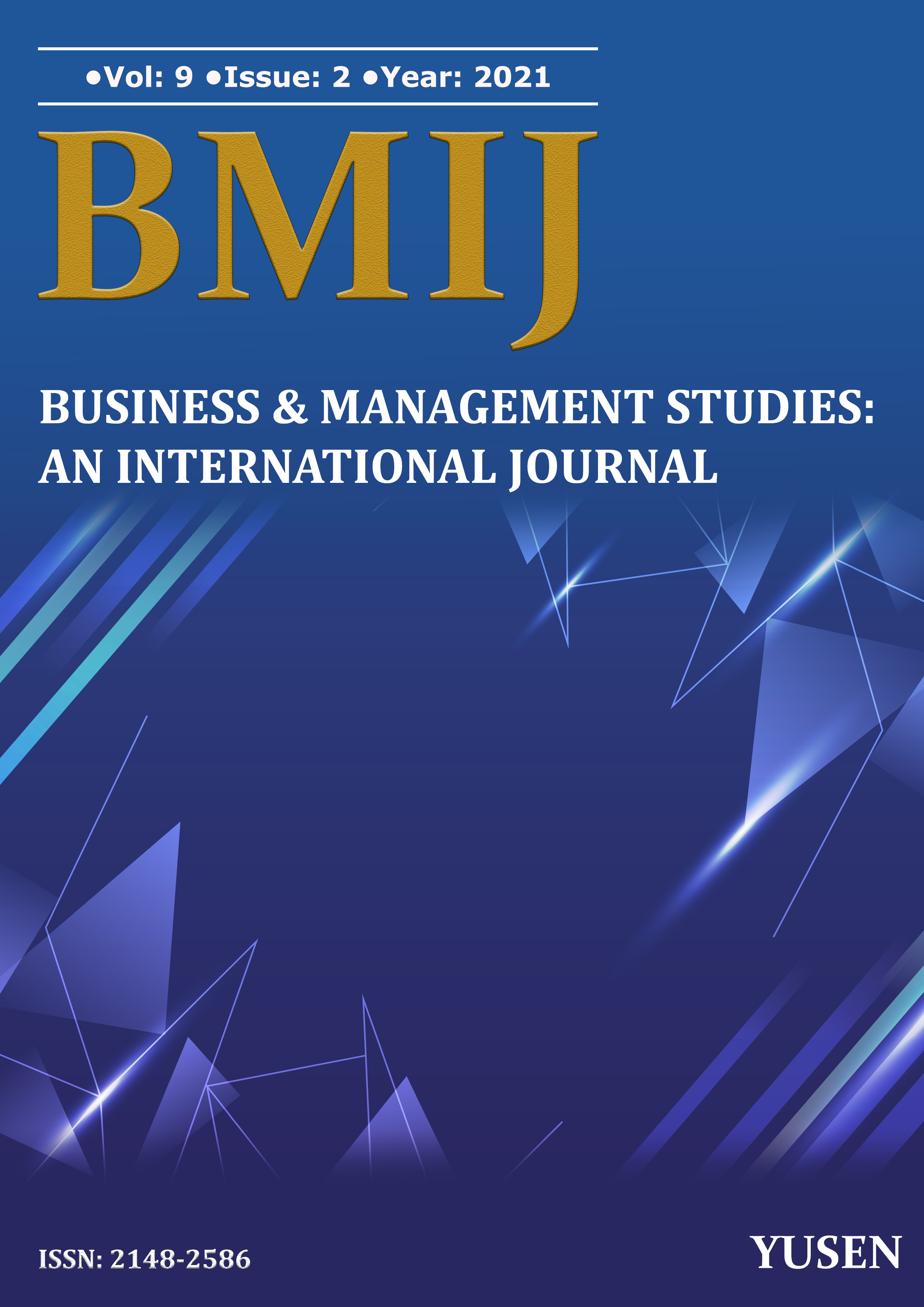Sosyal medya pazarlamasının elektronik ağızdan ağza iletişim niyeti üzerindeki etkisinde tüketici bağlılığının aracılık rolü

Yayınlanmış 25.06.2021
Anahtar Kelimeler
- Sosyal medya pazarlaması,
- Tüketici katılımı,
- Elektronik ağızdan ağza iletişim niyeti
- Social media marketing,
- Consumer engagement,
- e-Word-of-mouth communication intention
Nasıl Atıf Yapılır
Telif Hakkı (c) 2021 Didem Demir- Selçuk Yasin Yıldız

Bu çalışma Creative Commons Attribution-NonCommercial-NoDerivatives 4.0 International License ile lisanslanmıştır.
Nasıl Atıf Yapılır
Öz
Sosyal medya mecralarındaki kullanımın artmasıyla birlikte kişiler birbirleriyle çok daha fazla karşılıklı etkileşimde bulunmaktadırlar. Bu sebeple sosyal medya kullanan bireyler arasında gerçekleşen ağızdan ağıza iletişim faaliyetleri firmaların göz ardı etmemesi gereken bir olgu olarak karşımıza çıkmaktadır. Ancak sosyal medya pazarlaması faaliyetlerinin, ağızdan ağıza iletişimdeki rolüne ait yapılan çalışmalarda tüketici bağlılığının aracılık rolü bugüne kadar yeterli ilgiyi görmemiştir. Bu çalışmada sosyal medyanın e-wom niyeti üzerindeki etkisinde tüketici bağlılığının aracılık rolünün olup olmadığı araştırılmıştır. Çevrimiçi olarak hazırlanmış anket formu sosyal medya ve mobil iletişim uygulamalarını kullanan bireylere gönderilmiştir. 464 kişiden elde edilen kullanılabilir veriler AMOS paket program yardımı ile analiz edilmiştir. Yapısal eşitlik modellemesi kullanılarak yapılan hipotez testleri ile sosyal medya pazarlamasının, tüketici bağlılığı ve e-wom niyeti üzerinde olumlu ve anlamlı bir etkiye sahip olduğu belirlenmiştir. Ayrıca test sonuçlarına bağlı olarak tüketici bağlılığının da elektronik ağızdan ağıza iletişim niyeti üzerinde olumlu ve anlamlı bir etkiye sahip olduğu söylenebilir. Son olarak, bu çalışmada; tüketici bağlılığının, sosyal medya pazarlaması ile e-wom niyeti arasında aracılık etkisine sahip olduğu sonucuna ulaşılmıştır. Bu nedenle gerçekleştirilen bu çalışma sosyal medya pazarlaması literatürüne önemli katkılar sunmaktadır.
Referanslar
- Algesheimer, R., Dholakia, U. M., & Herrmann, A. (2005). The social influence of brand community: Evidence from European car clubs. Journal of marketing, 69(3), 19-34. https://doi.org/10.1509/jmkg.69.3.19.66363
- Ashley, C., & Tuten, T. (2015). Creative strategies in social media marketing: An exploratory study of branded social content and consumer engagement. Psychology & Marketing, 32(1), 15-27. https://doi.org/10.1002/mar.20761
- Bailey, A. A., Bonifield, C. M., & Elhai, J. D. (2021). Modeling consumer engagement on social networking sites: Roles of attitudinal and motivational factors. Journal of Retailing and Consumer Services, 59, 102348. https://doi.org/10.1016/j.jretconser.2020.102348
- Barger, V., W. Peltier, J., & Schultz, D. E. (2016). Social media and consumer engagement: A review and research agenda. Journal of Research in Interactive Marketing, 10(4). https://doi.org/10.1108/JRIM-06-2016-0065
- Baxendale, S., Macdonald, E. K., & Wilson, H. N. (2015). The impact of different touchpoints on brand consideration. Journal of Retailing, 91(2), 235-253. https://doi.org/10.1016/j.jretai.2014.12.008
- Biçer, D. F., & Erciş, A. (2020). Sosyal medyada viral pazarlama (elektronik ağızdan ağıza) faaliyetlerinin tüketici satın alım niyetine etkileri. Atatürk Üniversitesi Sosyal Bilimler Enstitüsü Dergisi, 24(3), 1555-1575.
- Boateng, S. L. (2019). Online relationship marketing and customer loyalty: A signaling theory perspective. International Journal of Bank Marketing, 37(1), 226-240. https://doi.org/10.1108/IJBM-01-2018-0009
- Bone, P. F. (1995). Word-of-mouth effects on short-term and long-term product judgments. Journal of business research, 32(3), 213-223. https://doi.org/10.1016/0148-2963(94)00047-I
- Brodie, R. J., Ilic, A., Juric, B., & Hollebeek, L. (2013). Consumer engagement in a virtual brand community: An exploratory analysis. Journal of business research, 66(1), 105-114. https://doi.org/10.1016/j.jbusres.2011.07.029
- Brown, T. A. (2015). Confirmatory factor analysis for applied research. In D. A. Kenny (Ed.), Methodology in the social sciences (Second ed.). The Guilford Press.
- Bui, T.-V. (2014). Social media on-a-stick: A uses and gratification approach toward helping mobile food vendors engage consumers on Instagram The University of Minnesota.
- Cerin, E., & MacKinnon, D. P. (2008). A commentary on current practice in mediating variable analyses in behavioural nutrition and physical activity. Public health nutrition, 12(8), 1182-1188. https://doi.org/10.1017/S1368980008003649
- Chatterjee, P. (2001). Online reviews: Do consumers use them? Advances in Consumer Research, 28(1), 129-133.
- Cheung, C. M. K., & Lee, M. K. O. (2012). What drives consumers to spread electronic word of mouth in online consumer-opinion platforms. Decision Support Systems, 53(1), 218-225. https://doi.org/10.1016/j.dss.2012.01.015
- Choi, C. S., Cho, Y.-N., Ko, E., Kim, S. J., Kim, K. H., & Sarkees, M. E. (2019). Corporate sustainability efforts and e-WOM intentions in social platforms. International Journal of Advertising, 38(8), 1224-1239. https://doi.org/10.1080/02650487.2019.1613858
- Choi, Y. K., Seo, Y., & Yoon, S. (2017). E-WOM messaging on social media: Social ties, temporal distance, and message concreteness. Internet Research, 27(3), 495-505. https://doi.org/10.1108/IntR-07-2016-0198
- Chu, S. C., & Kim, Y. (2011). Determinants of consumer engagement in electronic word-of-mouth (eWOM) in social networking sites. International journal of Advertising, 30(1), 47-75. https://doi.org/10.2501/IJA-30-1-047-075
- Chu, S.-C., & Kim, Y. (2011). Determinants of consumer engagement in electronic word-of-mouth (eWOM) in social networking sites. International Journal of Advertising, 30(1), 47-75. https://doi.org/10.2501/IJA-30-1-047-075
- Chu, S.-C., Lien, C.-H., & Cao, Y. (2019). Electronic word-of-mouth (eWOM) on WeChat: Examining the influence of sense of belonging, need for self-enhancement, and consumer engagement on Chinese travellers’ eWOM. International Journal of Advertising, 38(1), 26-49. https://doi.org/10.1080/02650487.2018.1470917
- Cuong, P. H. (2020). Factors influencing e-WOM online consumer goods purchase behavior: Evidence from Vietnam. Academy of Entrepreneurship Journal, 26(2), 1-11. https://doi.org/10.14505/jarle.v11.2(48).05
- De Valck, K., Van Bruggen, G. H., & Wierenga, B. (2009). Virtual communities: A marketing perspective. Decision support systems, 47(3), 185-203. https://doi.org/10.1016/j.dss.2009.02.008
- Deighton, J., & Kornfeld, L. (2009). Interactivity's unanticipated consequences for marketers and marketing. Journal of Interactive marketing, 23(1), 4-10. https://doi.org/10.1016/j.intmar.2008.10.001
- Demmers, J., Weltevreden, J. W., & van Dolen, W. M. (2020). Consumer engagement with brand posts on social media in consecutive stages of the customer journey. International Journal of Electronic Commerce, 24(1), 53-77. https://doi.org/10.1080/10864415.2019.1683701
- Devereux, E., Grimmer, L., & Grimmer, M. (2020). Consumer engagement on social media: Evidence from small retailers. Journal of Consumer Behaviour, 19(2), 151-159. https://doi.org/10.1002/cb.1800
- DiCiccio, T. J., & Efron, B. (1996). Bootstrap confidence intervals. Statistical science, 11(3), 189-228. https://doi.org/10.1214/ss/1032280214
- Dolan, R., Conduit, J., Fahy, J., & Goodman, S. (2016). Social media engagement behaviour: A uses and gratifications perspective. Journal of Strategic Marketing, 24(3/4), 261-277. https://doi.org/10.1080/0965254X.2015.1095222
- Elseidi, R. I., & El-Baz, D. (2016). Electronic word of mouth effects on consumers' brand attitudes, brand image and purchase intention: An empirical study in Egypt. The Business & Management Review, 7(5), 268-276.
- Fatma, M., Ruiz, A. P., Khan, I., & Rahman, Z. (2020). The effect of CSR engagement on eWOM on social media. Journal of Organizational Analysis, 28(4), 941-956. https://doi.org/10.1108/IJOA-10-2019-1895
- Fornell, C., & Larcker, D. F. (1981). Structural equation models with unobservable variables and measurement error: Algebra and statistics. Journal of Marketing Research, 18(3), 382-388. https://doi.org/10.1177/002224378101800313
- Froget, J. R. L., Baghestan, A. G., & Asfaranjan, Y. S. (2013). A uses and gratification perspective on social media usage and online marketing. Middle-East Journal of Scientific Research, 15(1), 134-145.
- Gao, H., Tate, M., Zhang, H., Chen, S., & Liang, B. (2018). Social media ties strategy in international branding: An application of resource-based theory. Journal of International Marketing, 26(3), 45-69. https://doi.org/10.1509/jim.17.0014
- Giakoumaki, C., & Krepapa, A. (2020). Brand engagement in self‐concept and consumer engagement in social media: The role of the source. Psychology & Marketing, 37(3), 457-465. https://doi.org/10.1002/mar.21312
- Grewal, R., Cline, T. W., & Davies, A. (2003). Early-entrant advantage, word-of-mouth communication, brand similarity, and the consumer decision-making process. Journal of Consumer Psychology, 13(3), 187-197. https://doi.org/10.1207/S15327663JCP1303_01
- Gvili, Y., & Levy, S. (2018). Consumer engagement with eWOM on social media: the role of social capital. Online Information Review, 42(4), 482-505. https://doi.org/10.1108/OIR-05-2017-0158
- Gvili, Y., & Levy, S. (2018). Consumer engagement with eWOM on social media: The role of social capital. Online information review, 42(4), 482-505. https://doi.org/10.1108/OIR-05-2017-0158
- Hair, J. F., Black, W. C., Babin, B. J., & Anderson, R. E. (2014). Multivariate data analysis (New International ed.). Pearson.
- Hayes, A. F. (2009). Beyond Baron and Kenny: Statistical mediation analysis in the new millennium. Communication monographs, 76(4), 408-420. https://doi.org/10.1080/03637750903310360
- Hayes, A. F. (2018). Partial, conditional, and moderated moderated mediation: Quantification, inference, and interpretation. Communication monographs, 85(1), 4-40. https://doi.org/10.1080/03637751.2017.1352100
- Henseler, J., Ringle, C. M., & Sarstedt, M. (2015). A new criterion for assessing discriminant validity in variance-based structural equation modeling. Journal of the Academy of Marketing Science, 43(1), 115-135. https://doi.org/10.1007/s11747-014-0403-8
- Hollebeek, L. D., Glynn, M. S., & Brodie, R. J. (2014). Consumer brand engagement in social media: Conceptualization, scale development and validation. Journal of interactive marketing, 28(2), 149-165. https://doi.org/10.1016/j.intmar.2013.12.002
- Hu, L. t., & Bentler, P. M. (1999). Cutoff criteria for fit indexes in covariance structure analysis: Conventional criteria versus new alternatives. Structural equation modeling: A multidisciplinary journal, 6(1), 1-55. https://doi.org/10.1080/10705519909540118
- Huang, L.-Y., Hsieh, Y.-J., & Wu, Y.-C. J. (2014). Gratifications and social network service usage: The mediating role of online experience. Information & Management, 51(6), 774-782. https://doi.org/10.1016/j.im.2014.05.004
- Huang, W. D., Johnson, T. E., & Han, S.-H. C. (2013). Impact of online instructional game features on college students’perceivedmotivational support and cognitive investment: A structural equation modeling study. Internet and Higher Education, 17, 58-68. https://doi.org/10.1016/j.iheduc.2012.11.004
- Islam, J. U., & Rahman, Z. (2016). Linking customer engagement to trust and word-of-mouth on Facebook brand communities: An empirical study. Journal of Internet Commerce, 15(1), 40-58. https://doi.org/10.1080/15332861.2015.1124008
- Kara, T. (2016). Gençler neden snapchat kullanıyor kullanımlar ve doyumlar yaklaşımı üzerinden bir araştırma. Intermedia International e-Journal, 3(5), 262-277. https://doi.org/10.21645/intermedia.2017.14
- Khan, M. L. (2017). Social media engagement: What motivates user participation and consumption on YouTube? Computers in human behavior, 66(1), 236-247. https://doi.org/10.1016/j.chb.2016.09.024
- Kim, A. J., & Ko, E. (2012). Do social media marketing activities enhance customer equity? An empirical study of luxury fashion brand. Journal of Business research, 65(10), 1480-1486. https://doi.org/10.1016/j.jbusres.2011.10.014
- Kim, B., Yoo, M. M., & Yang, W. (2019). Online engagement among restaurant customers: The importance of enhancing flow for social media users. Journal of Hospitality & Tourism Research, 44(2), 252-277. https://doi.org/10.1177/1096348019887202
- Kim, J. E., Lloyd, S., & Cervellon, M. C. (2016). Narrative-transportation storylines in luxury brand advertising: Motivating consumer engagement. Journal of Business Research, 69(1), 304-313. https://doi.org/10.1016/j.jbusres.2015.08.002
- Kim, S., Martinez, B., McClure, C. S., & Kim, S. H. (2016). E-WOM intentions towards social media messages. Atlantic Marketing Journal, 5(1), 137-154.
- Ko, H., Cho, C.-H., & Roberts, M. S. (2005). Internet uses and gratifications: A structural equation model of interactive advertising. Journal of Advertising, 34(2), 57-70. https://doi.org/10.1080/00913367.2005.10639191
- Kumar, V., Aksoy, L., Donkers, B., Venkatesan, R., Wiesel, T., & Tillmanns, S. (2010). Undervalued or overvalued customers: Capturing total customer engagement value. Journal of service research, 13(3), 297-310. https://doi.org/10.1177/1094670510375602
- Lee, K.-T., & Koo, D.-M. (2012). Effects of attribute and valence of e-WOM on message adoption: Moderating roles of subjective knowledge and regulatory focus. Computers in human behavior, 28(5), 1974-1984. https://doi.org/10.1016/j.chb.2012.05.018
- Lee, S., & Kim, B. G. (2017). The impact of qualities of social network service on the continuance usage intention. Management Decision, 55(4), 701-729. https://doi.org/10.1108/MD-10-2016-0731
- Leonidas, H., Boutsouki, C., Pigadas, V., & Zotos, Y. (2016). PEER: Looking into consumer engagement in e-WOM through social media. In P. Verlegh, H. Voorveld, & M. Eisend (Eds.), The digital, the classic, the subtle and the alternative (6th. ed., pp. 11-24). Springer. https://doi.org/10.1007/978-3-658-10558-7_2
- Levy, M. R., & Windahl, S. (1984). Audience activity and gratifications: A conceptual clarification and exploration. Communication research, 11(1), 51-78. https://doi.org/10.1177/009365084011001003
- Liang, C.-J., & Wang, W.-H. (2007). Customer relationship management of the information education services industry in Taiwan: Attributes, benefits and relationship. The Service Industries Journal, 27(1), 29-46. https://doi.org/10.1080/02642060601038627
- Liu, X., Min, Q., & Han, S. (2020). Understanding users' continuous content contribution behaviours on microblogs: An integrated perspective of uses and gratification theory and social influence theory. Behaviour & Information Technology, 39(5), 525-543. https://doi.org/10.1080/0144929X.2019.1603326
- Liu, X., Shin, H., & Burns, A. C. (2019). Examining the impact of luxury brand's social media marketing on customer engagement: Using big data analytics and natural language processing. Journal of Business research, 125, 815-826. https://doi.org/10.1016/j.jbusres.2019.04.042
- Livingstone, S. (2004). The challenge of changing audiences: Or, what is the audience researcher to do in the age of the Internet? European journal of communication, 19(1), 75-86. https://doi.org/10.1177/0267323104040695
- Malhotra, N. K., & Birks, D. F. (2006). Marketing research: An applied approach (Updated second European edition ed.). Essex: England: Prentice Hall.
- Malhotra, N. K., & Dash, S. (2106). Marketing research: An applied orientation (7th. ed.). Pearson.
- Mochon, D., Johnson, K., Schwartz, J., & Ariely, D. (2017). What are likes worth? A Facebook page field experiment. Journal of Marketing Research, 54(2), 306-317. https://doi.org/10.1509/jmr.15.0409
- Naylor, R. W., Lamberton, C. P., & West, P. M. (2012). Beyond the “like” button: The impact of mere virtual presence on brand evaluations and purchase intentions in social media settings. Journal of Marketing, 76(6), 105-120. https://doi.org/10.1509/jm.11.0105
- Okazaki, S., Rubio, N., & Campo, S. (2014). Gossip in social networking sites: Why people chitchat about ad campaigns. International Journal of Market Research, 56(3), 317-340. https://doi.org/10.2501/IJMR-2014-022
- Omar, N. A., Kassim, A. S., Alam, S. S., & Zainol, Z. (2018). Perceived retailer innovativeness and brand equity: Mediation of consumer engagement. The Service Industries Journal, 38, 1-27. https://doi.org/10.1080/02642069.2018.1548614
- Orel, F. D., & Arik, A. (2020). Sosyal medya pazarlama faaliyetlerinin çevrimiçi tüketici katılımı ve satın alma niyeti üzerindeki etkisi: Moda markaları örneği. Erciyes Üniversitesi Sosyal Bilimler Enstitüsü Dergisi, 49, 146-161.
- Ortiz, J., Chih, W.-H., & Teng, H.-C. (2017). Electronic word of mouth in the Taiwanese social networking community: Participation factors. Internet Research, 27(5), 1058-1084. https://doi.org/10.1108/IntR-09-2016-0276
- Papacharissi, Z., & Mendelson, A. (2011). Toward a new(er) sociability: Uses, gratifications, and social capital on Facebook. In S. Papathanassopoulos (Ed.), Media perspectives for the 21st century (Communication and society). Routledge.
- Rossmann, A., Ranjan, K. R., & Sugathan, P. (2016). Drivers of user engagement in eWoM communication. Journal of Services Marketing, 30(5). 541-553. https://doi.org/10.1108/JSM-01-2015-0013
- Rossmann, A., Ranjan, K. R., & Sugathan, P. (2016). Drivers of user engagement in eWoM communication. Journal of Services Marketing, 30(5), 541-553. https://doi.org/10.1108/JSM-01-2015-0013
- Rucker, D. D., Preacher, K. J., Tormala, Z. L., & Petty, R. E. (2011). Mediation analysis in social psychology: Current practices and new recommendations. Social and Personality Psychology Compass, 5(6), 359-371. https://doi.org/10.1111/j.1751-9004.2011.00355.x
- Ruggiero, T. E. (2000). Uses and gratifications theory in the 21st century. Mass Communication and Society, 3(1), 3-37. https://doi.org/10.1207/S15327825MCS0301_02
- Sa’ait, N., Kanyan, A., & Nazrin, M. F. (2016). The effect of e-WOM on customer purchase intention. International Academic Research Journal of Social Science, 2(1), 73-80.
- Sashi, C. M., Brynildsen, G., & Bilgihan, A. (2019). Social media, customer engagement and advocacy: An empirical investigation using Twitter data for quick service restaurants. International Journal of Contemporary Hospitality Management, 31(3). https://doi.org/10.1108/IJCHM-02-2018-0108
- Sawhney, M., Verona, G., & Prandelli, E. (2005). Collaborating to create: The Internet as a platform for customer engagement in product innovation. Journal of interactive marketing, 19(4), 4-17. https://doi.org/10.1002/dir.20046
- Si, S. (2016). Social media and its role in marketing. Business and Economics Journal, 7(1), 203-208.
- Siraj, S. A. (2007). Synthesis of the structure and functions of the uses and gratification model. European Journal of Scientific Research, 17(3), 399-408.
- So, K. K. F., King, C., & Sparks, B. (2014). Customer engagement with tourism brands: Scale development and validation. Journal of Hospitality & Tourism Research, 38(3), 304-329. https://doi.org/10.1177/1096348012451456
- Srivastava, M., & Sivaramakrishnan, S. (2020). Exploring The Triad of eWOM, eWOM Generator Engagement and Consumer Engagement: A Conceptual Framework. Journal of Management Research, 20(1). 34-46.
- Strutton, D., Taylor, D. G., & Thompson, K. (2011). Investigating generational differences in e-WOM behaviours: For advertising purposes, does X= Y? International Journal of Advertising, 30(4), 559-586. https://doi.org/10.2501/IJA-30-4-559-586
- Sun, Y., Gonzalez-Jimenez, H., & Wang, S. (2020). Examining the relationships between e-WOM, consumer ethnocentrism and brand equity. Journal of Business research, 1-10. https://doi.org/10.1016/j.jbusres.2019.09.040
- Tafesse, W. (2016). An experiential model of consumer engagement in social media. Journal of Product & Brand Management. https://doi.org/10.1108/JPBM-05-2015-0879
- Thongsri, N., Shen, L., Bao, Y., & Alharbi, I. M. (2018). Integrating UTAUT and UGT to explain behavioural intention to use M-learning: A developing country’s perspective. Journal of Systems and Information Technology, 20(3), 278-297. https://doi.org/10.1108/JSIT-11-2017-0107
- Toor, A., Husnain, M., & Hussain, T. (2017). The impact of social network marketing on consumer purchase intention in Pakistan: Consumer engagement as a mediator. Asian Journal of Business and Accounting, 10(1), 167-199.
- Tsimonis, G., & Dimitriadis, S. (2014). Brand strategies in social media. Marketing Intelligence & Planning, 32(3), 328-344. https://doi.org/10.1108/MIP-04-2013-0056
- Van Doorn, J., Lemon, K. N., Mittal, V., Nass, S., Pick, D., Pirner, P., & Verhoef, P. C. (2010). Customer engagement behavior: Theoretical foundations and research directions. Journal of service research, 13(3), 253-266. https://doi.org/10.1177/1094670510375599
- Verhoef, P. C., Reinartz, W. J., & Krafft, M. (2010). Customer engagement as a new perspective in customer management. Journal of service research, 13(3), 247-252. https://doi.org/10.1177/1094670510375461
- Verma, R., Jahn, B., & Kunz, W. (2012). How to transform consumers into fans of your brand. Journal of Service Management, 23(3), 344-361. https://doi.org/10.1108/09564231211248444
- Vivek, S. D., Beatty, S. E., & Morgan, R. M. (2012). Customer engagement: Exploring customer relationships beyond purchase. Journal of marketing theory and practice, 20(2), 122-146. https://doi.org/10.2753/MTP1069-6679200201
- Voorhees, C. M., Brady, M. K., Calantone, R., & Ramirez, E. (2016). Discriminant validity testing in marketing: An analysis, causes for concern, and proposed remedies. Journal of the Academy of Marketing Science, 44(1), 119-134. https://doi.org/10.1007/s11747-015-0455-4
- Wagner, C., & Majchrzak, A. (2006). Enabling customer-centricity using wikis and the wiki way. Journal of management information systems, 23(3), 17-43. https://doi.org/10.2753/MIS0742-1222230302
- Yayla, H. M. (2018). Kullanımlar ve doyumlar bağlamında Dokuz Eylül Üniversitesi Güzel Sanatlar Fakültesi öğrencilerinin sosyal medya kullanımı: İnstagram örneği. Selçuk İletişim, 11(1), 40-65. https://doi.org/10.18094/josc.346756
- Yoo, C. W., Sanders, G. L., & Moon, J. (2013). Exploring the effect of e-WOM participation on e-Loyalty in e-commerce. Decision Support Systems, 55(3), 669-678. https://doi.org/10.1016/j.dss.2013.02.001
- Yoon, S.-J. (2012). A social network approach to the influences of shopping experiences on e-WOM. Journal of Electronic Commerce Research, 13(3), 213-223.
- Zaltman, G. (2003). Tüketici nasıl düşünür (A. S. Koç, Trans.). Mediacat Kitapları.
- Zhang, M., Hu, M., Guo, L., & Liu, W. (2017). Understanding relationships among customer experience, engagement, and word-of-mouth intention on online brand communities. Internet Research, 27(4), 839-857. https://doi.org/10.1108/IntR-06-2016-0148
- Zhao, X., Lynch Jr, J. G., & Chen, Q. (2010). Reconsidering Baron and Kenny: Myths and truths about mediation analysis. Journal of Consumer Research, 37(2), 197-206. https://doi.org/10.1086/651257



